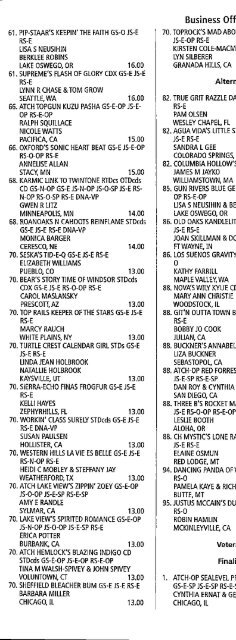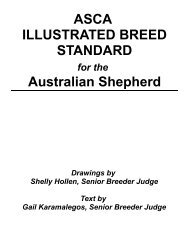You also want an ePaper? Increase the reach of your titles
YUMPU automatically turns print PDFs into web optimized ePapers that Google loves.
Tracking Field Notes<br />
dog typically canvases the entire space,<br />
checking every pebble and leaf until he<br />
finds the article.<br />
Clearly, your tracking dog must not<br />
be reluctant to approach and sniff articles.<br />
On the contrary, he has to feel driven to<br />
discover and investigate objects scented<br />
by human strangers, so you must adopt<br />
training methods that invest these objects<br />
with value, and you must work continually<br />
to develop and maintain your dog's article<br />
drive. Off the track, play tug games with<br />
articles to enhance their value, shell games<br />
to acquaint your dog with articles made of<br />
hard materials, and search-and-find games<br />
to develop your dog's scenting skills. On the<br />
track, maintain article value by rewarding<br />
your dog lavishly for every article find,<br />
and allow him to resort to natural search<br />
patterns when he detects article scent. Let's<br />
look at the details of this training.<br />
Off-the'track training is the criticalfirst<br />
step.<br />
*Glen Johnson, the first trainer to design a<br />
reliable step-by-step method for tracking<br />
training, devoted his initial training sessions<br />
to off-the-track work: playing retrieving<br />
games with gloves. Johnson worked to<br />
intensify the dog's natural retrieving drive<br />
until he could rely on using the glove as<br />
a lure for tracking training. The dog's<br />
article drive was well-established before<br />
he began running his first training tracks.<br />
Johnson maintained the value ofthe glove<br />
by playing retrieving games every time the<br />
dog found it at the end of a track.<br />
The advanced tests that have been<br />
developed since the Johnson era require the<br />
dog to detect and indicate a wide variety<br />
of articles —check-book covers, socks,<br />
gloves, metal switch-plates and plumbing<br />
fixtures, and hard plastic glasses cases<br />
and soap dishes, to name a few. Johnson's<br />
preliminaryoff-the-tracktrainingprinciple<br />
is even more critical to the dog's training<br />
for these advanced tests. Whether or not<br />
he is willing to retrieve them, the dog must<br />
feel excitedabout approachingand sniffing<br />
objects made of all kinds of materials.<br />
Building and maintaining his enthusiasm<br />
for interacting with these objects requires<br />
continual reinforcement.<br />
Positive trainer attitude toward the dog's<br />
natural sniffing behavior during the<br />
course of everyday activities underlies<br />
successful off-the-track article<br />
training.<br />
Investigating objects by sniffing them<br />
provides the dog's most important and<br />
detailed information. The successful<br />
trainer respects the dog's need for<br />
scent-workeducation through sniffing<br />
experience. By contrast, discouraging<br />
sniffing inhibits the dog's learning.<br />
A frustrated sniffer becomes a dull<br />
sniffer. When training your tracking<br />
dog, keep in mind these important<br />
"do's and don't's:"<br />
1.Do encourageyour tracking dog to "^<br />
approach, sniff, and interact with a<br />
wide variety of safe items in your<br />
home, including your clothing and<br />
belongings. Dogs naturally love anything<br />
that carries human scent, especially their<br />
owner's scent, so use this trait to your<br />
advantage. Leave one of your old stinky<br />
t-shirts in his crate.<br />
2. Do allow your dog to sniff new items<br />
you bring into your home, grocery bags,<br />
for example. Dogs are naturally curious<br />
about new things, and a tracking dog<br />
needs to feel empowered to investigate<br />
what interests him.<br />
3. Do actively promote new scenting<br />
experiences, just as you would promote<br />
new opportunities for socialization.<br />
1. Do not punish your tracking dog for<br />
sniffing. If he sniffs on his Obedience<br />
"long downs," he's worried or bored.<br />
Provide interesting distractions. Lay<br />
some baited targets infront ofhim, just<br />
out of reach, to give him something to<br />
think about.<br />
2. Do notpunish your tracking dog severely<br />
for chewing up shoes or other personal<br />
belongings. The risk of trying to teach<br />
him a "lesson he'll neverforget" is that<br />
you may succeed! You can't afford to<br />
instill avoidance behavior for the very<br />
items the dog will be required tofind on<br />
the track. Remember, your dog makes<br />
all ofthe decisions when he is working<br />
twentyfeet ahead ofyou on the tracking<br />
line, and ifthe scent ofleather terrifies<br />
him, it will take only one whiff to send<br />
himflying.<br />
No, ifhe's just ruined your comfy<br />
fleece-lined slippers, you have only<br />
yourself to blame, and you've acquired<br />
a pair of excellent tracking articles.<br />
Store valuable items out of his reach.<br />
Spray bitter apple on baskets and other<br />
chewables that you can't hide.<br />
Formal off-the-track article training<br />
gamesfall roughly into three categories:<br />
tug games with gloves and socks, shell<br />
games designed to entice the dog to sniff<br />
and mouth objects made of different<br />
materials, and search games such as ball<br />
play or "hide-the-toy," that develop the<br />
dog's ability to find objects by scenting<br />
them.<br />
1. Play tug with tracking articles to<br />
transform them into highly valued lures.<br />
Favorite tug toys are used as lures in Agility<br />
training for distance work and to build<br />
drive for contact obstacles and tunnels.<br />
"Tug" is the game of choice for training<br />
scent detection dogs to alert on drugs and<br />
other contraband substances. The trainees<br />
play tug with rags impregnated with the<br />
substances they will be commanded to<br />
find. The working dogs are rewarded with<br />
vigorous games of tug for each of their<br />
finds. Take a tip from the professionals and<br />
play tug with old work gloves and worn-out<br />
socks; tie knots in the socks to strengthen<br />
them so your dog can't tear them to pieces<br />
during the first session.<br />
2. Play shell games to encourage your<br />
tracking dog to interact with objects<br />
made of metal and hard plastic. It's<br />
relatively easy to teach dogs to detect<br />
and discriminate cloth and leather articles<br />
because those materials areattractive totug<br />
and retrieve, and they hold human scent<br />
AUSSIE TIMES I <strong>July</strong>-<strong>Aug</strong>ust <strong>2005</strong> 97



